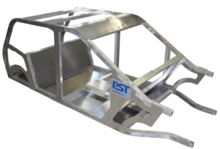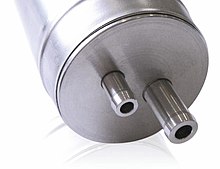
Magnetic pulse welding (MPW) is a solid state welding process that uses magnetic forces to weld two workpieces together. The welding mechanism is most similar to that of explosion welding.[1] Magnetic pulse welding started[clarification needed] in the early 1970s, when the automotive industry began to use solid state welding.[citation needed]
The primary advantage of using magnetic pulse welding is that the formation of brittle intermetallic phases is avoided, allowing the joining of metals which cannot be effectively joined by fusion welding.[citation needed] Additionally, the process is nearly instantaneous and does not require shielding gas or other welding consumables.
Process[edit]

Magnetic pulse welding is based on a very short electromagnetic pulse (<100 μs), which is obtained by a fast discharge of capacitors through low inductance switches into a coil. The pulsed current with a very high amplitude and frequency (500 kA and 15 kHz) produces a high-density magnetic field, which creates an eddy current in one of the work pieces. Repulsive Lorentz forces are created and a high magnetic pressure well beyond the material yield strength causes acceleration of one of the work pieces to velocities of up to 500 m/s (1,100 mph) upon collision.[citation needed]
During magnetic pulse welding a high plastic deformation is developed along with high shear strain and oxide disruption due to the jet[clarification needed] and high temperatures near the collision zone. This leads to a solid state weld due to the microstructure refinement (dislocation cells, slip bands, micro twins and local recrystallization).[2]
Principles[edit]
In order to achieve a strong weld, several conditions have to be reached:[3]
- Jetting condition: the collision has to be subsonic compared to the local material's speed of sound to generate a jet.
- High pressure regime: the impact velocity has to be sufficient to obtain a hydrodynamic regime, otherwise the parts will only be crimped or formed.
- No fusion during the collision: If the pressure is too high, the materials can locally melt and re-solidify. This can cause a weak weld.
The main difference between magnetic pulse welding and explosive welding is that the collision angle and the velocity are almost constant during the explosive welding process, while in magnetic pulse welding they continuously vary.[citation needed]
Numerical simulations of MPW[edit]
Various numerical investigations were carried out to predict the interface behavior of the MPW and the in-flight behavior of the flyer to determine the collision conditions. Generally, the flyer velocity prior to the impact governs the interfacial phenomena. This is the characteristic parameter that should be known based on the process and adjustable process parameters. Although experimental measurements using laser velocimetry methods provide an accurate assessment of the flyer velocity; one example of such measurement is Photon Doppler velocimetry (PDV); numerical computation offers a better description of the flyer velocity in terms of spatial and temporal distribution. [citation needed]
A multi-physics computation of the MPW process can take into account of the electrical current through the coil and compute the physical behavior for an electromagnetic-mechanical coupled problem. These simulations also allow the thermal effect during the process to be included.[4][5] A 3D example model used for LS-DYNA simulation is also used, and it also provides some details of the physical interactions of the process, the governing equations, the resolution procedure, and both boundary and initial conditions.[citation needed] The model is used to show the capability of 3D computation to predict the process behavior and particularly, the flyer kinematics and macroscopic deformation.[6][7]
References[edit]
- ^ Weman, Klas (2003), Welding processes handbook, CRC Press, pp. 91–92, ISBN 978-0-8493-1773-6.
- ^ A. Stern, V. Shribman, A. Ben-Artzy, and M. Aizenshtein, Interface Phenomena and Bonding Mechanism in Magnetic Pulse Welding, Journal of Materials Engineering and Performance, 2014.[page needed]
- ^ Magnetic Pulse Welding: J.P. Cuq-Lelandais, S. Ferreira, G. Avrillaud, G. Mazars, B. Rauffet: Welding windows and high velocity impact simulations.[page needed]
- ^ Sapanathan, T.; Raoelison, R.N.; Buiron, N.; Rachik, M. (2016). "Magnetic Pulse Welding: An Innovative Joining Technology for Similar and Dissimilar Metal Pairs". Joining Technologies. doi:10.5772/63525. ISBN 978-953-51-2596-9. S2CID 62881653.
- ^ Raoelison, R.N.; Sapanathan, T.; Padayodi, E.; Buiron, N.; Rachik, M. (2016). "Interfacial kinematics and governing mechanisms under the influence of high strain rate impact conditions: Numerical computations of experimental observations". Journal of the Mechanics and Physics of Solids. 96: 147–161. Bibcode:2016JMPSo..96..147R. doi:10.1016/j.jmps.2016.07.014.
- ^ L'Eplattenier, Pierre; Cook, Grant; Ashcraft, Cleve; Burger, Mike; Imbert, Jose; Worswick, Michael (May 2009). "Introduction of an Electromagnetism Module in LS-DYNA for Coupled Mechanical-Thermal-Electromagnetic Simulations". Steel Research International. 80 (5): 351–8.
- ^ I. Çaldichoury and P. L’Eplattenier, EM Theory Manual, Livermore Software Technology Corporation, California, USA, 2012.[page needed]
External links[edit]
- The Electromagnetic Pulse Technology (EMPT): Forming, Welding, Crimping and Cutting by R. Schäfer, P. A. Pasquale and S. W. Kallee
- 3D Impacts Modeling of the Magnetic Pulse Welding Process and Comparison to Experimental Data by J.-P. Cuq-Lelandais*, G. Avrillaud, S. Ferreira, G. Mazars, A. Nottebaert, G. Teilla, V. Shribman
- Automotive Applications of Electromagnetic Pulse Technology (EMPT) by S. W. Kallee, R. Schäfer and P. A. Pasquale.
- Special Issue "Impulse-Based Manufacturing Technologies" by Verena Psyk et al., J. Manuf. Mater. Process. 2021, 5(3), 96, ISSN 2504-4494.